Chris Baty's Blog, page 96
September 14, 2018
Sociological Worldbuilding

As we begin to dive into NaNo Prep season, we’ve talked to some participants to get the inside scoop on how to best prepare for November. Today, NaNoWriMo participant Robin Pegau shares some wisdom to help you build your fictional world:
Have you ever read a dystopia and thought that its interpretations fall flat? Or looked at a marginalized character and gone, “That’s not how that works?”
Welcome to sociology in writing.
Sociology studies how societies function. It asks questions like, “What makes an opera more culturally valuable than a movie?” and “How do we perpetuate class differences in childrearing?”
Using sociology in your novel can help build the backbone of your character and your world. It not only tells you what is important, but why, so you can expand upon initial ideas and construct a past and future for your world.
Think on how different identities and aspects interact. An easy step to using sociology in worldbuilding is to ask yourself: how does a system benefit those in power? How can they use it to affect marginalized people?
Say in our fictional world, there’s two groups: the Grok and the Hali. The Grok managed to subjugate the Hali at some point long ago, violently. Wars beget propaganda, so the Hali got tagged as “the enemy.”
Over the years, the Grok have tried to establish their own culture—food, language, holidays, etc.—as what is “correct”, and thus eradicate any trace of “the enemy.” Hali are punished for deviating from the standards the Grok enforce. Maybe their language isn’t taught, or is outright banned. Maybe the Grok see Hali food as gross or unusual. Maybe Grok holidays get public celebration with media coverage, time off of work, and easily found merchandise whereas Hali holidays don’t.
Grok ways become the norm. Even when the Hali population increases and almost equals the Grok population, children have been taught for decades that the Grok-dominant way is normal. The culturally-marked Hali remain deviant. They’re seen as extra suspicious, so law enforcement doesn’t believe them, doctors don’t trust them, banks don’t want to lend to them, teachers send Hali kids to detention more. They’re now less healthy, less rich, and more criminalized. They have fewer opportunities and more setbacks.
Congratulations, you’ve built a proletariat. The Grok have their workforce.
You too come from these processes. Consider: how can you use the sociological events that have impacted your life to create engaging stories? Where do different groups collide, and what happens at the intersections? What are your world’s tools of oppression?
Go wrangle your populaces.

Robin is a product of the society she lives in. In particular, she attends Mount Holyoke College to fulfill social obligations towards higher education. She studies sociology and computer science, though in a twist she originally planned to use both of those to further her authorial plans. Her love of science fiction comes from her family’s socialization, though she’s certainly not protesting all the sci-fi she’s read and written over the years.
Top photo by Samuel Zeller on Unsplash.
September 12, 2018
6 Essential Tips for a Successful NaNoWriMo

As we begin to dive into NaNo Prep season, we’ve talked to some participants to get the inside scoop on how to best prepare for November. Today, writer Clara Nyx shares her top tips for “winning” NaNoWriMo:
Most people, at some point in their life, have thought of writing a novel. But few of them start writing that novel. And even fewer can say: “I wrote a book.” The reasoning behind this is simple, and everyone who’s tried their hand at writing knows it: writing a novel is hard and time-consuming. The excitement to tell your story turns into: “This makes no sense. An 8-year-old could write a better story. My vocabulary is trash.”
In this mindset, it’s easy to postpone writing that novel for a few more months until you become more literate, wise, intelligent, or a better writer. Then those “few months” turn into a few years as you realize that your vocabulary hasn’t changed, you haven’t gotten smarter… You haven’t improved as a writer because you didn’t write.
Want to become a writer? Then write as much as you can! Overcome procrastination and sit your butt down in front of that blank page.
Easier said than done, but not impossible. How do you make this writing experience different? How do you start writing when all you can think of is failure?
Easy. You prepare for the month to come. What better way to start this writing experience than with equally frustrated writers? Here are 5 essential tips for a successful NaNoWriMo experience from a writer who has yet to “lose”:
1. Start preparing the moment you make the decision to participate in NaNoWriMo.It’s not enough to have a book idea. You need to prepare mentally. So make a list of the reason(s) you decided to write a novel, somewhere easy for you to look at and remember. Trust me, you want to remember why. Because, as I mentioned before, writing a novel is time-consuming. It will take you months, maybe years to have a decent story. And in that time you’ll brainstorm, write, edit, rewrite, edit, cut, add, rewrite, workshop, rewrite and rewrite some more. It’s really easy to lose yourself in the process, right? But that’s why you have your little list: to remember the excitement you had for writing that story.
Write down as many reasons as you can think of in your list. You can always add more points later. They can be lighthearted reasons like “I want to try something new”, “I like writing”, “I’m bored”, etc. Or it can be one damn good reason. Of course the definition of that “one good reason” changes from person to person. For me it is always along the lines of “I want to raise awareness for ______” or “I have this moral point that I want to share with the word.”
2. Brainstorm about your plot ahead of time.Have a story idea? Excellent. But as I said, it won’t be enough. Not for NaNoWriMo, at least. Because if you try to turn that idea into a plot in 31 days, you might start off decent, but at some point, you’ll stop and ask yourself: “Where am I going with this? What is the purpose of this scene? This chapter? Character? Dialogue? What’s the purpose of life?!”
The prospect of deleting 50,000 words because they basically lead you nowhere is terrifying, and it’s one of the reasons people don’t meet the monthly word goal. Why bother when you’ll delete later? Well, sorry to break it to you, but you’ll rewrite 99% of that first draft, pantser or not.
It’s ok not to know where your plot is going while you’re writing your first draft. Maybe you’ll write one scene that will make you realize where you want to go. If not, at least you got to know your characters and setting better. But if you want to nail the plot in the first draft? Then you’ll have to plan. A lot. Ideally, start a month or two before NaNoWriMo. Brainstorm different ideas about the setting, the relationships between characters. Rearrange your ideas into categories and expand those ideas even more. Yes, it is a lot of work, but it’ll help keep you on track when you start to write.
3. Prepare your writing space and supplies.You might find yourself more excited to write if you have a clean and organized desk. Dispose of everything you don’t need for your writing session. Decide on your notebook/writing program based on your “style”. Create a playlist of writing music. Research what you need.
Maybe set up how you’re going to access coffee or a snack—though unfortunately, in the past I’ve found these can also be excuses for procrastinating writing: “I can’t write now because I’m too lazy to make myself a cup of coffee and I cannot write without coffee.” (Spoiler alert: you can write just as well with water.) Be aware that in the middle of NaNoWriMo, you’ll try to look for any excuse not to write that day—no matter how stupid that excuse is.
4. Don’t forget to read.Neck-deep in that terrible first draft, you’ll feel as though you forgot to write. How do people talk? Do they really sigh that much? How do I describe a character or setting?
Take a deep breath and read a chapter or two of your favorite book or a book that inspires you. Know an author that writes phenomenal dialogue? Take a peek at his work. An author with appealing and relatable characters? Take notes on what makes you like those characters so much.
5. Try creating a monthly schedule—and sticking to it.Got something you can do before NaNoWriMo starts? Do it. Creating a monthly schedule doesn’t always work because, most of the time, things don’t go as planned. But it’s worth a shot, especially if you get other things out of the way first.
Make time in your day to sit down and write. MAKE is the key word here. You cannot find time, you can only create it by not procrastinating and instead accomplishing something productive—like writing a novel. Is there a time of day when you watch TV or play video games or take naps? Not anymore, because you’ll be spending that time writing. It will feel unusual at first, but trust me, at the end of NaNoWriMo, you’ll feel guilty about watching TV and not writing.
Remember that you don’t have to write 1,667 words in one sitting. If you can’t write for two hours straight, try with shorter sessions of half an hour. But don’t skip those sessions. I often found myself thinking: “ I’ll write later in the day.” I never did, I just spent the next day catching up.
6. Ignore all of the above and do it your way.Those 5 tips are what I do, and they work for me. But they may not work for you. Finding a way that works for you is a lengthy process filled with trial and error, but it is something every aspiring writer should do. How do you know if you’re a planner and not a pantser if you haven’t tried doing both? How do you know writing in the morning is more productive than writing in the evening if you haven’t tried that too?
Don’t be afraid to try new writing routines. You might find a new favorite. You might find something that most definitely does not work for you. Or you’ll combine your old routine with a new one and create something that is unique to you.
Clara Nyx is an artist, avid reader and book blogger, who sometimes does beta-reading services. She specializes in dystopias and post-apocalyptic stories, as well as classic literature. When not writing book reviews, she works on her first novel and blogs about her interests, personal experiences and issues she feels are not represented enough in modern-day society. Check out her blog.
Top photo by Ian Stauffer on Unsplash.
September 10, 2018
Road Trip to NaNo: Know Your Characters’ Culture
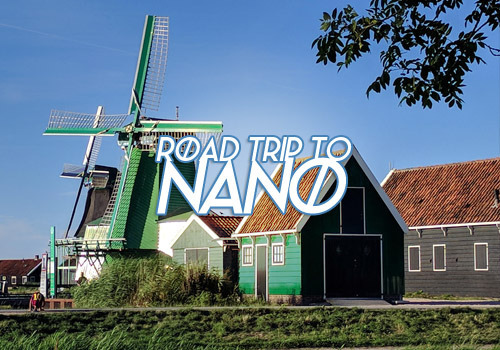
NaNoWriMo is an international event, and we’re taking a Road Trip to NaNo to hear about the stories being written every year in our hundreds of participating regions. Today, Isabelle Grimmelikhuisen, a participant in the Europe :: The Netherlands region, shares how her region has shaped her writing:
Hallo! Welkom! Welcome to the Netherlands, or at least a small, very small part of it. While my tiny district has no more than 160,000 people, our history is rich. While we’ve had some well-known Dutch writers and artists here, we don’t have much of a legacy to our name. And yet, there is one thing we have plenty: culture.
We have silly sayings and traditions, words that mean nothing to any other person outside our region, old stories we learn from a young age, while someone from the next town over might never hear of it in a lifetime. It’s our local culture, and we hold on to it wherever we go.
There is one place, however, that’s swamped with more culture than anywhere else in our little region. We call it Zaanse Schans, a small place very popular with tourists; people from different countries, different cities, different cultures. And even when they’re nowhere near their countries, far away from their cities, they hold on to their culture. It shows in the way they dress, they act, the things they value.
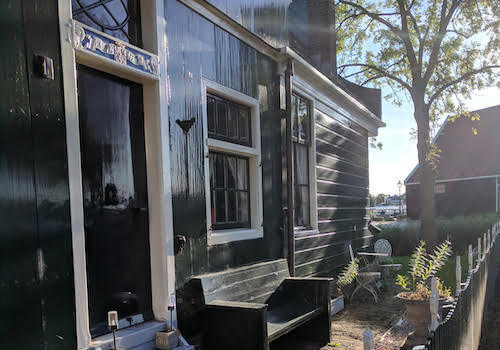
Everyone does this. Everyone. Even the background characters in your novel. Now, I’m not asking you to go into detail about every main, side, and background character’s culture, but take it into consideration. People in a city might have a certain trait or habit in common. Two people from different places might have a discussion on the correct name of an item. Some parts of a culture are nationwide, like the way they dress or their traditional music. For example, I know few people who are very fond of Dutch music, and yet it’s a part of our culture. There are some songs everyone knows, cause you can’t have a party without them, but aside from that, there aren’t many fans.
Culture doesn’t always have to be liked to be appreciated. A character doesn’t have to love their culture, or certain aspects of it. In fact, they might loathe it so much they try to hide it, act the opposite. But even if they avoid it, it shapes them as a person, adding so much to their personality and character.
I challenge you to add this depth to your characters. Give them a culture to shape themselves around. Whether their culture involves their entire lifestyle being shaped for them (like monks in a monastery), or something small and simple (such as the music they like to listen to, or an item of clothing they wear), give your characters something to make them more of a real version of themselves.

Isabelle is a 20-year-old aspiring writer. Her preferred genre is young adult fantasy, as she thoroughly enjoys tossing her characters into an unknown world and following them as they try to find their way. When she isn’t writing people into unknown worlds, she practices her hobby of photography or busies herself studying to some day work in tourism.
September 7, 2018
How to Begin Writing Every Day
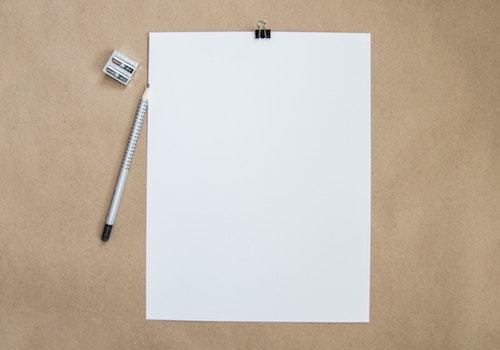
For some writers, September means the start of meticulously planning out what they’re going to write in November. For some pantsers, even thinking about writing is still months away. But no matter what your writing style is, just starting anything can be the hardest part. Today, writer Rosario Martinez shares some words of wisdom about beginnings:
You want to write a story. It’s the story that’s been there in the back of your mind. The one you’ve frequently thought about writing down, the one you thought you’d never get to tell. Until one day, poof! There it is, like a shiny new pencil. Quickly gather your notebook—a new one that you’ve assigned for this occasion. You might already have a couple notebooks that you’ve gathered over the years for this exact moment. All those empty pages hiding away the hundreds of possibilities. All the stories. All of them just waiting for you to sit down and write.
The real beginning—the part before the story ever starts—is where we as writers have to condition ourselves to write. Perhaps not everyday, but at least thinking about writing constantly, is the hardest part.
Think of all the people who candidly say they have always wanted to write a book but simply don’t have the time. If there is something that I have learned since beginning my novel, it’s that the right time to write will not come, bells ringing, at a particular time of the day. I remember I wanted to write at specific times of the day, every day, uninterrupted, to complete my word count each day. I was disappointed when it didn’t happen and decided to start anew every day after that.
It was a huge relief when I began to be flexible about my writing time. In the early days I set an event on my phone calendar around the time that I’d most likely be home to remind me that this was a good time to write. Today the event is still there; it’s there the 365 days of the year. While I don’t write every day, it helps to keep writing on my mind, it helps me begin every day.
The writing journey itself has several beginnings, middles and endings—it’s kind of meta if you really think about it. Each day, gradually we carve out the time to write. How? By thinking about our writing in the way one would approach a math problem, step by step. (Math, right? Fractions, or something.) But it makes sense to think about it this way.
I often thought about writing a book as some unattainable kind of magic, and that was daunting. It’s too overwhelming to think about a whole book all at once. All the parts start to move and often you don’t know where to begin. That was one of the things that kept me from writing. I started out collecting scenes I’d written, names I liked for characters, possible locations, and backstory. I had the skeleton of a story, and while I had an ending in mind, I had absolutely no idea where to begin.
The truth is, there is no one way to start your story, because only you know your story. I started writing out of order and that got me through for a couple of scenes—not chapters. Then I wrote the ending before I wrote the beginning and circled back to the start. It took a few tries and rewrites until now I think I’m at a good spot.
The beginning is always tough. I’m here to tell you that it will be okay you will get through it. All you have to do is sit and begin.

Rosario Martinez is a writer in Dallas, Texas where she lives with her husband and their 4 sweet but demanding cats. She’s currently working on her debut YA Fantasy novel set in a parallel world where magic isn’t the only rising power. She has too many flannel things and believes a good bowl of nachos is life. To follow her journey to publication, visit her blog or find her on Twitter @lemmonavenue08 and Instagram @rosariowrites.
Top photo by Kelly Sikkema on Unsplash.
September 5, 2018
NaNo Prep Season Is Here!
 Hey Wrimos, did you know that NaNo Prep season officially kicks off today?
Hey Wrimos, did you know that NaNo Prep season officially kicks off today? For you planners out there (or for pantsers who want to try something new), now’s the time to start preparing to write this fall. We’ll be providing plenty of help to get you started on this blog, but be sure to check out our other resources on the NaNo Prep page, and to keep an eye out for webcasts and other announcements on our calendar. You can also hop into the forums to chat with other Wrimos about anything writing related… or really, just anything!
Oh, and be sure to pick up some cool NaNo flair for your social media sites.
September 3, 2018
5 Ways to Generate Story Ideas

As September begins, we’re already starting to think about prepping for NaNoWriMo. But what if you don’t have any idea what you want to write about when November rolls around? Today, Brooke, a member of our Young Writers Program, shares some of her tips for generating story ideas:
Camp NaNoWriMo has finished, August has ended, and for many folks, school has started again. With summer coming to a close, some people are already plotting and planning for the upcoming NaNoWriMo: Not so much a difficult task as just a time-consuming one, although it can be the difference between reaching your word count before the end of November or falling short of 50,000. The problem is, what if you don’t have any ideas for stories yet? When this is the case, there are many ways of coming up with fresh ideas.
1. People WatchCharacters are supposed to be both realistic and 3-dimensional, so what better way to get inspired than by watching real people? Any public place can work for this, just grab a notepad and try not to look suspicious jotting down the characteristics of complete strangers. The amount of stories that can come from a couple of minutes watching people is amazing, and all it takes is a piece of paper and a little bit of time.
2. Word AssociationStart with one vague word, and then begin linking it with others. Repeat the process until an entire sheet is filled with nothing but related words. By the end of the page, themes will have started emerging, and with them hopefully some story ideas. Combine these topics until eventually a supple plot has been developed. The only thing left to do is further the story and write the book!
3. FreewriteWrite a scene that appeals to you. It doesn’t have to make sense, just write it, whatever it is. The tense may stay inconsistent, and the character’s name may switch between paragraphs, but as long as this one scene is something you like, chances are a novel based off it may be equally intriguing. If nothing else, the activity is also good practice for developing a location and characters.
4. Writing PromptsWriting prompts can be found all around the internet. No matter what social media platform you use, it’s not hard to find accounts full of nothing but prompts and story inspiration. Different types work for different people—scraps of dialogue may work for some, while character inspiration or locations can be more helpful for others.
5. Keep a JournalI know, it’s common advice, but that’s for a reason. Either buy a small notebook to keep with you, or start a document on your phone. Try to keep it near you, so whenever you come up with a couple of lines of witty dialogue, or think up an interesting plot point, it’s convenient to write it down. Whenever you’re in need of a story idea, then you’ll have pages full of them.
Besides this, always be looking for new ideas. Inspiration is everywhere, so it never hurts to step outside your comfort zone to try some unusual tactics for creating characters, worlds, and plots for your next novel. With all of these ideas and a little motivation, it should be no problem preparing for your next novel by November.
Brooke is an aspiring young author from the United States. She first started writing in 2016, and now, at age thirteen, has written two novels, several short stories, and articles. Other than writing, she spends her spare time learning piano, drawing, and running. NaNoWriMo has helped her both of her books, and will hopefully continue to motivate her for countless more Novembers. Her current projects include a collection of poetry, a science fiction novel, and a fantasy short story.
Top photo by Gift Habeshaw on Unsplash.
August 31, 2018
Join Our #InstaWrimo Instagram Challenge in September!
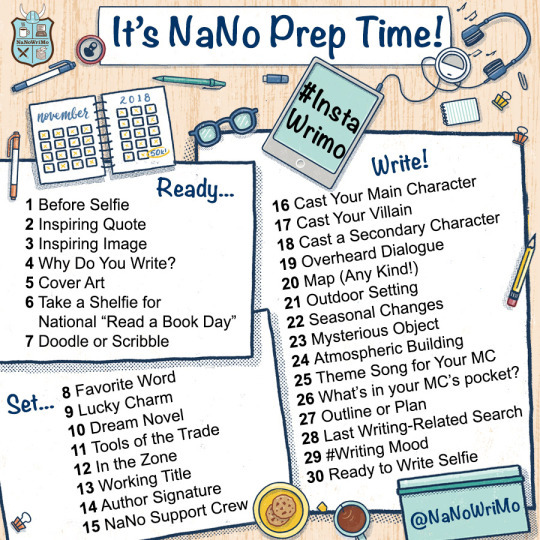
A novel is a lot like mold. Mold doesn’t just appear all of a sudden on those strawberries you meant to eat but didn’t. It starts as spores that drift through the air, seeking the right combination of temperature and light and dampness. It settles in, speck by speck, and slowly grows into something more.
Okay, I know, gross (note to self: throw out those old strawberries). But I like the metaphor because that’s often how stories start: you make space in your day and mind to dream, and the ideas drift down, spore by spore. After many days and weeks (and sometimes months!) they grow into characters and scenes you can shape into an outline.
NaNoWriMo is coming up in November, so this September, we want to help you grow your mold—er, novel—with our second ever month-long #InstaWrimo challenge. We designed a month of Instagram prompts to get you thinking about characters, setting, and story. All you need to join in is an Instagram account.
Follow @NaNoWriMo on Instagram.Use the 30 photo prompts listed in the graphic above to start thinking about your novel. We’ll post the full challenge prompt on Instagram, but it will also be available in this post if you need to refer back to it.
These prompts are just suggestions—you don’t have to be literal, though if you want to take these prompts very literally, that can result in some fun pictures, too. You can post a photo for each of the prompts, or choose just a few. You can post one every day, or all at once. There aren’t any strict rules—the most important part is having fun!
Make sure to tag any posts with the #InstaWrimo hashtag so we can find them. We’ll pick photos from the challenge to feature on our own Instagram account throughout the month. Follow the hashtag to see what our awesome community is up to, and to get inspired.
Use your imagination, get creative, and get ready to write!
August 29, 2018
“Write for yourself. Write for the story. And write, also, for...
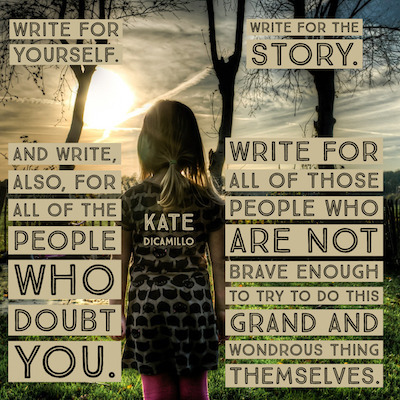
“Write for yourself. Write for the story. And write, also, for all of the people who doubt you. Write for all of those people who are not brave enough to try to do this grand and wondrous thing themselves.”
If you need some extra encouragement today, let the words of 2012 Pep Talker Kate DiCamillo remind you that you are brave, and your creative projects are worthwhile. Read the full pep talk here.
Shoutout to NaNoWriMo participant yieng for creating the beautiful image!
August 28, 2018
How NaNoWriMo Helped Me Overcome Perfectionism

How has NaNoWriMo changed your life? Today, writer and editor Sarah Howard reveals how NaNoWriMo helped her escape perfectionism and learn to put words on a page:
I am a writer.
I am also a recovering perfectionist.
You can probably sense this was not a good combination. I had trouble starting projects because I wanted perfect ideas. I had trouble finishing projects because they didn’t live up to my expectations. And even when I did have a finished piece, it never felt good enough to let anyone read. It’s so hard to break these patterns, especially when they’ve been going on forever. But National Novel Writing Month helped me do it.
I first participated in NaNoWriMo when I was a high school senior. I wrote around 12,000 words on my first try, which was the most I’d ever written on anything. I should have been proud, but instead I thought, wow, I didn’t even get halfway done. Some writer I am. I tried again the next two years with similar results, hitting the wall around 15k each year and feeling disappointed.
However, though I didn’t succeed in the ultimate goal, I loved everything else NaNoWriMo gave me. I was introduced to their great community of writers, who talked about writing in a language I understood but had never heard anywhere else before. I received email pep talks from famous authors who described frustrations with their own writing and offered encouragement. My perfectionist brain had insisted to me that if you had the talent and were destined to be a good writer, it would be easy. Finding out it was hard for everyone made a huge difference in my mindset. It showed that no one’s writing was perfect, and no one’s process was effortless, even the pros.
“Finding out it was hard for everyone made a huge difference in my mindset. It showed that no one’s writing was perfect, and no one’s process was effortless, even the pros.”After college, I decided to try NaNoWriMo again. This time, I decided my goal was not to write an amazing novel, but instead to see if I could actually write 50,000 words in a month. When I thought it over and came up with a story idea, I figured out the most important key: I just had to have 50,000 words. Not one of them needed to be perfect.
Of course, NaNoWriMo’s entire philosophy is wrapped up in this idea, but it took me that long to let myself believe it. To give myself permission to know a line or paragraph or scene won’t be perfect or even good, and write it anyway. Because only when it’s on the page can you revise it and work to make it better.
With the pressure off, I was finally able to hit 50,000 words. Watching the progress of the little blue bar fill up, turn green and then finally purple with Winner! inside was such an awesome feeling. And while that novel never saw the light of day outside of a Word doc, I had accomplished my goal. I printed out my winner certificate and stuck it on my fridge with pride.
I continued to participate and win the next two years, each time not only hitting the goal, but improving my writing skills and crafting more coherent storylines. After that, I further built on what I had learned, attending writing conferences and earning an MFA degree. I’m still writing, and now I know that finally figuring out it was OK to just put words on the page is the single most important thing I’ve ever learned. This is why I returned to do Camp NaNoWriMo in 2016 and NaNoWriMo itself last year. I have found no better way to generate work and quiet the perfectionist brain.

Sarah Howard is a writer, editor and escapist. She received her MFA in Creative Writing from Hamline University, where she was assistant editor for Water~Stone Review, and has been published in Midwestern Gothic, MN Artists and Twin Cities Runoff. She lives in Minneapolis with her television. Visit her website at sarahhowardwrites.com.
Top photo by Angelina Litvin on Unsplash.
August 24, 2018
Try a Learning Circle at Peer 2 Peer University

Feeling like you need a little extra help to feel confident about your writing? Today, Municipal Liaison and librarian Jordan Draves talks about Peer 2 Peer University, which they used to create their own personalized writing courses:
As a librarian who loves writing and has participated in NaNoWriMo for eons, it only made perfect sense to teach the craft to others looking to write a novel. After all, who doesn’t want free writing classes at the library?! Enter Peer 2 Peer University. P2PU is a nonprofit organization that seeks to get free online courses into libraries and community centers as Learning Circles.
What’s a Learning Circle? These are lightly facilitated online courses that cover a wide variety of topics from creative writing to computer languages and even social justice issues. Students take the classes at home or in the library, then meet with their classmates to discuss the work and help each other succeed. This model of learning increases the chance they will finish the course, compared to taking it alone.
P2PU has several online courses related creative writing, but I took the opportunity to create my own course based on what I was looking for in a writing class with the Learning Circle model in mind. The class, entitled “Learn To Write Fiction Beginner Course”, can be found on P2PU’s list of courses. It uses online articles combined with writing exercises to teach topics such as character development, writing dialogue, and plotting your novel. Basically, it’s an 8-week intensive course geared toward teaching you the real nuts and bolts of the craft and get you writing!
When I facilitated it for the first time I advertised it as a way to prepare for National Novel Writing Month, tapping into my Municipal Liaison powers and messaging all of the participants located in my region to let them know about it. Being able to email so many writers in the area brought instant success as the class quickly filled up and we needed to close registration early! If you’re not an ML, but you want those super powers, contact your local ML and they can get the word out for you.
“What’s a Learning Circle? These are lightly facilitated online courses that cover a wide variety of topics from creative writing to computer languages and even social justice issues.”For those who have a love of writing, this class is a lot of fun. I have now facilitated it twice, and both times it was wildly popular with many students staying in contact with each other and continuing to meet as a writing group long after the class ended. Most of the students were NaNoWriMo participants but not all of them were.
This probably sounds a bit daunting for the first time facilitator. But it’s not as scary as it sounds! As a facilitator, you don’t need to know anything about the topic because you’re not the one teaching the material and P2PU offers lots of advice for new facilitators so you’re never left feeling alone or confused. The great thing about the P2PU website is that they have a registration page for participants to register their intent to take the class. Students will also get reminder emails every week, and facilitators get a way to email the entire class at once.
As far as my own writing classes go, students have asked for more classes on other writing topics, so I have created a second course available through P2PU entitled “Learn To Write Fiction: World-Building” which uses the same model to teach the basics of world-building for those interested in writing fantasy or science fiction.
I’m excited to bring more writing courses to the writers who need them and I hope my experiences have inspired you to try out one of the Learning Circles at P2PU, or something similar.

Jordan is a librarian in Boston who enjoys recommending good books to patrons and facilitating writing classes at the library. Their favorite food is spaghetti and their favorite cookie is chocolate chip. In 2016 they adopted a retired racing greyhound, renaming her after the main character in Josh Lanyon’s Adrien English Mystery Series, because why not name a beloved dog after a favorite character?! Jordan identifies as agender/ace and has no preferred pronouns. They also go by Anna.
Top image licensed under Creative Commons from charlesflickr on Flickr.
Chris Baty's Blog
- Chris Baty's profile
- 63 followers



